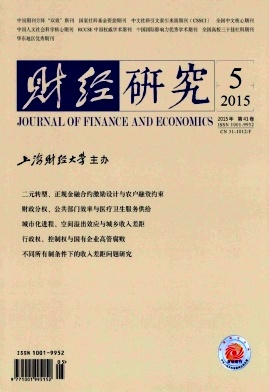外部资源价格冲击与中国工业部门通胀的内生关联研究
财经研究 2015 年 第 41 卷第 05 期, 页码:
摘要
参考文献
摘要
文章基于近年来国际资源市场价格激烈波动的现实背景,选择中国33个工业部门以构建反映部门间内在联系的全局向量自回归模型(GVAR),分析外部资源价格冲击对工业部门价格和产出波动的短期效应,继而通过分解各个工业部门的通货膨胀压力来源,探寻资源价格冲击的主要传导路径。研究表明:(1)国际原油价格冲击对能源、化工和基础原材料部门的价格和产出的短期影响较大,而国际工业原材料价格冲击的影响则集中在冶金和机械等工业部门;(2)外部资源价格冲击的影响存在滞后性,但并未产生第二轮通胀效应;(3)工业部门的通货膨胀压力存在显著的溢出效应,国际原油和工业原材料的价格冲击沿着产业链内在联系构成的固定路径进行传导。在GVAR模型中使用新的工业部门间关联权重后,上述结果基本稳健。文章的研究结论为政府有关部门应对国际资源价格冲击提供了一个细化的行业视角。
[1]段继红.国际油价冲击对中国宏观经济的影响[J].统计研究, 2010, (7):25-29.
[2]耿鹏, 赵昕东.基于GVAR模型的产业内生联系与外生冲击分析[J].数量经济技术经济研究, 2009, (12):32-45.
[3]胡援成,张朝洋.美元贬值对中国通货膨胀的影响:传导途径及其效应[J].经济研究, 2012, (4):101-112.
[4]林伯强, 林立民.中国战略石油储备的最优规模[J].世界经济, 2010, (8):72-92.
[5]林伯强, 牟敦国.能源价格对宏观经济的影响——基于可计算一般均衡(CGE)的分析[J].经济研究, 2008, (11):88-101.
[6]柳明,宋潇.石油价格波动对中国宏观经济的影响——基于DSGE模型的分析[J].南开经济研究, 2013, (6):74-96.
[7]任若恩, 樊茂清.国际油价波动对中国宏观经济的影响:基于中国IGEM模型的经验研究[J].世界经济, 2010, (12):28-47.
[8]任泽平, 潘文卿, 刘起运. 原油价格波动对中国物价的影响——基于投入产出价格模型[J].统计研究, 2007, (11):22-28.
[9]孙宁华, 江学迪.能源价格与中国宏观经济:动态模型与校准分析[J].南开经济研究, 2012, (2):20-32.
[10]魏巍贤,高中元,彭翔宇. 能源冲击与中国经济波动——基于动态随机一般均衡模型的分析[J].金融研究, 2012, (1):51-64.
[11]王云清.能源价格冲击与中国的宏观经济:理论模型、数值分析及政策模拟[J].经济学动态, 2014, (2):44-57.
[12]张延群.全球向量自回归模型的理论、方法及其应用[J].数量经济技术经济研究, 2012, (4):136-149.
[13]中国经济增长与宏观稳定课题组.外部冲击与中国的通货膨胀[J].经济研究, 2008, (5):4-18.
[14]Berument H,Tasci H. Inflationary effect of crude oil prices in Turkey[J].Physica A:Statistical Mechanics and its Applications, 2002,316(1-4): 568-580.
[15]Cuado J,Pérez de Gracia F. Do oil price shocks matter? Evidence for some European countries [J].Energy Economics,2003,25(2): 137-154.
[16]Dedola L,Lippi F. The monetary transmission mechanism: Evidence from the industries of five OECD countries [J].European Economic Review,2005,49(6): 1543-1569.
[17]Mauro F,Smith L V,Dees s,etal.Exploring the international linkages of the Euro area: A global VAR analysis[J].Journal of Applied Econometrics,2007,22(1): 1-38.
[18]Doroodian K,Boyd R. The linkage between oil price shocks and economic growth with inflation in the presence of technological advances: A CGE model[J].Energy Policy,2003,31(10): 989-1006.
[19]Eickmeier S,Ng T. How do credit supply shocks propagate internationally? A GVAR approach[J]. European Economic Review,2015,74(C):128-145.
[20]Galesi A,Lombardi M J. External shocks and international inflation linkages:A global VAR analysis[R].ECB Working Paper No.1062, 2009.
[21]Lescaroux F,Mignon V. On the influence of oil prices on economic activity and other macroeconomic and financial variables [J].OPEC Energy Review,2008, 32(4): 343-380.
[22]Pesaran M,Schuermann T,Weiner S. Modeling regional interdependencies using a global errorcorrecting macroeconometric model[J]. Journal of Business and Economic Statistics,2004,22(2): 129-162.
[23]Pesaran M,Shin Y,Smith R. Structural analysis of vector error correction models with exogenous I(1) variables[J]. Journal of Econometrics, 2000, 97(2): 293-343.
[2]耿鹏, 赵昕东.基于GVAR模型的产业内生联系与外生冲击分析[J].数量经济技术经济研究, 2009, (12):32-45.
[3]胡援成,张朝洋.美元贬值对中国通货膨胀的影响:传导途径及其效应[J].经济研究, 2012, (4):101-112.
[4]林伯强, 林立民.中国战略石油储备的最优规模[J].世界经济, 2010, (8):72-92.
[5]林伯强, 牟敦国.能源价格对宏观经济的影响——基于可计算一般均衡(CGE)的分析[J].经济研究, 2008, (11):88-101.
[6]柳明,宋潇.石油价格波动对中国宏观经济的影响——基于DSGE模型的分析[J].南开经济研究, 2013, (6):74-96.
[7]任若恩, 樊茂清.国际油价波动对中国宏观经济的影响:基于中国IGEM模型的经验研究[J].世界经济, 2010, (12):28-47.
[8]任泽平, 潘文卿, 刘起运. 原油价格波动对中国物价的影响——基于投入产出价格模型[J].统计研究, 2007, (11):22-28.
[9]孙宁华, 江学迪.能源价格与中国宏观经济:动态模型与校准分析[J].南开经济研究, 2012, (2):20-32.
[10]魏巍贤,高中元,彭翔宇. 能源冲击与中国经济波动——基于动态随机一般均衡模型的分析[J].金融研究, 2012, (1):51-64.
[11]王云清.能源价格冲击与中国的宏观经济:理论模型、数值分析及政策模拟[J].经济学动态, 2014, (2):44-57.
[12]张延群.全球向量自回归模型的理论、方法及其应用[J].数量经济技术经济研究, 2012, (4):136-149.
[13]中国经济增长与宏观稳定课题组.外部冲击与中国的通货膨胀[J].经济研究, 2008, (5):4-18.
[14]Berument H,Tasci H. Inflationary effect of crude oil prices in Turkey[J].Physica A:Statistical Mechanics and its Applications, 2002,316(1-4): 568-580.
[15]Cuado J,Pérez de Gracia F. Do oil price shocks matter? Evidence for some European countries [J].Energy Economics,2003,25(2): 137-154.
[16]Dedola L,Lippi F. The monetary transmission mechanism: Evidence from the industries of five OECD countries [J].European Economic Review,2005,49(6): 1543-1569.
[17]Mauro F,Smith L V,Dees s,etal.Exploring the international linkages of the Euro area: A global VAR analysis[J].Journal of Applied Econometrics,2007,22(1): 1-38.
[18]Doroodian K,Boyd R. The linkage between oil price shocks and economic growth with inflation in the presence of technological advances: A CGE model[J].Energy Policy,2003,31(10): 989-1006.
[19]Eickmeier S,Ng T. How do credit supply shocks propagate internationally? A GVAR approach[J]. European Economic Review,2015,74(C):128-145.
[20]Galesi A,Lombardi M J. External shocks and international inflation linkages:A global VAR analysis[R].ECB Working Paper No.1062, 2009.
[21]Lescaroux F,Mignon V. On the influence of oil prices on economic activity and other macroeconomic and financial variables [J].OPEC Energy Review,2008, 32(4): 343-380.
[22]Pesaran M,Schuermann T,Weiner S. Modeling regional interdependencies using a global errorcorrecting macroeconometric model[J]. Journal of Business and Economic Statistics,2004,22(2): 129-162.
[23]Pesaran M,Shin Y,Smith R. Structural analysis of vector error correction models with exogenous I(1) variables[J]. Journal of Econometrics, 2000, 97(2): 293-343.
引用本文
苏梽芳, 渠慎宁, 陈昌楠. 外部资源价格冲击与中国工业部门通胀的内生关联研究[J]. 财经研究, 2015, 41(5): 0.
导出参考文献,格式为:





 6874
6874  4377
4377

